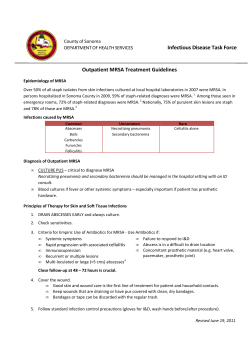
Schiffert Health Center Skin Infections www.healthcenter.vt.edu Information for Dealing With Staph or MRSA
Schiffert Health Center www.healthcenter.vt.edu Patient Information: About Skin Infections Self-Care When To See Your HCP Dealing with Staph or MRSA Information for Dealing With Staph or MRSA Skin Infections ABOUT SKIN INFECTIONS1 THE BEST WAY TO PREVENT INFECTIONS IS SIMPLE a yellow crust. It can be spread by scratching. This infection often occurs on the face.2 SER CLEAN Skin Infections start when bacteria get into a — WASH YOUR HANDS. cut or scrape. Even ones you can’t see (i.e. Infected hair roots (follicles)—small Washing your hands often with soap and shaving and through eczema, psoriasis and acne bumps under the skin at the base of the hair. They warm water also conditions). Bacteria live on everyone’s skin and may itch.1 helps to prevent colds & flu. usually cause no harm. But when staphylococcus Antibacterial bacteria get into your body through a break in the soaps are not needed.1 skin, they can cause a “staph” infection. Staph WHEN TO SEE YOUR HEALTH CARE infections may spread to other people by skin-to-skin PROVIDER: contact and from shared items such as towels, soap You have signs of infection such as pain, clothes and sports equipment. Also, beware of bedding Surprising Fact redness, swelling and heat, and oozing pus or with wound drainage on it. blood1 or other drainage. Staph infections are becoming harder to treat. Some germs are “resistant” to antibiotics. They are called MRSA New symptoms develop during or after you get treated.1 (methicillin-resistant staphylococcus aureus) DEALING WITH STAPH OR MRSA SKIN INFECTIONS: Immediate Self-Care: Wash cuts, scrapes and sores with soap and water; then keep them clean and cover them with bandages (changed 1-3 times per day).2 Consult Schiffert Health Center’s Wound Care Information Sheet located at http://www.healthcenter.vt.edu/pdf/ WoundCare.pdf and then call us to make an appointment. Avoid contact with other people’s cuts or sores and any materials that have come in contact with them.1 Avoid sharing personal items such as soap, towels, razors and sports equipment.1 Clean and wash sports clothing and equipment 1 after each use. DO NOT squeeze or try to pop bumps or pimples. WASH YOUR HANDS before and after handling dressings or wound site, even if you wear gloves. DO NOT use hot tubs, swimming pools or take a soaking bath until wounds are healed. Warm (not hot) showers are okay. DO NOT use loofas, sponges, or body poufs for bathing. Avoid harsh soaps like Dial® and Irish Spring® and don’t bathe with bar soaps. (Bar soaps can harbor bacteria) Cleanse the wound areas as directed with a cleanser like PHISOHEX® cleanser* three times a week until wounds are healed. Always use an unscented moisturizer on your body to prevent dry skin. During these times you can use cleanser around the wound areas if your body’s skin becomes too dry or irritated. Use paper towels to dry the wound site(s) after bathing to avoid spreading the infection through wound contact with your bath towel. SHAVING until wound(s) is healed. You may use a Some common skin infections caused by staph are1: NO depilatory (ex: Nair®). THROW AWAY your old razor! Use Boils—tender, red lumps that swell and get white heads like very big pimples. Boils form on oily or moist skin such as the neck, armpits, groin and buttocks. They may break open and ooze pus or blood.1 Impetigo—blisters with fluid in them, which pop and get Copyright © Schiffert Health Center Revised March 2010 only disposable razors for parts of body you can shave until wounds are completely healed. If wounds are located on the face, eyelids, etc., THROW AWAY appropriate facial make-up. (Remember...make-up should not be used when wounds are located in facial McComas Hall 540-231-6444 healthcenter@vt.edu Information for Dealing With Staph or MRSA Skin Infections mild moisturizing liquid body wash such as Camay® or Dove® soap (or generic) in liquid form (prevents removal of the protective acid mantle on the skin which protects against microbes). Throw away any bar soap. areas.) DO NOT SHARE with other people: lotions, towels, clothes, razors, make-up, soaps and/or sports equipment that you used while you had wound(s). Again, THROW disposable items away. Ask your practitioner or your wound care nurse FINISH ALL ANTIBIOTICS THE PRACTITIONER ORDERS FOR for further information. YOU — the last few pills kill the toughest germs. sports and/or sexual activity) can spread the skin infection. Even with the wound covered by a dressing there is still risk of spreading the infection — SO DISCUSS your risks with your practitioner or wound care nurse. ww The bacteria may be concentrated up in WASH YOUR HANDS BEFORE AND AFTER TOUCHING YOUR EYES, NOSE, MOUTH OR FACE! your nose so USE PROPER RESPIRATORY ETIQUETTE (disposable tissues; sneeze into your sleeve; alcohol gel hand sanitizer to clean hands). KEEP your hands away from your face. To help prevent recurrences of this type of infection, Care recommendations may vary based on the individual, number of wounds and where the wounds are located on the body. SER CLEAN SKIN TO SKIN CONTACT (including contact Helpful Prevention Activity avoid taking very hot tub baths or showers. Use a * PHISOHEX® (brand of hexachlorophene detergent cleanser) is an antibacterial sudsing emulsion for topical administration. PHISOHEX® contains a colloidal dispersion of hexachlorophene 3% (w/w) in a stable emulsion consisting of entsufon sodium, petrolatum, lanolin cholesterols, methylcellulose, polyethylene glycol, polyethylene glycol monostearate, lauryl myristyl iethanolamide, sodium enzoate, and water. pH is adjusted with hydrochloric acid. Entsufon sodium is a synthetic detergent. 1 Source: Washington State Department of Health DOH Pub 130-046 reprinted with permission. 2 Source: Adapted from Washington State Department of Health DOH Pub 130-046 with permission. Page 2 of 2 Copyright © Schiffert Health Center — Revised March 2010
© Copyright 2025





















